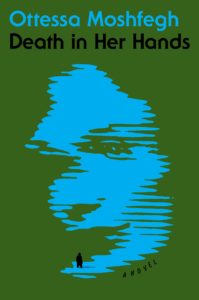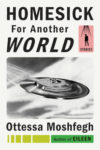
[Penguin Press; 2020]
Death in Her Hands is Ottessa Moshfegh’s fifth book. It’s about a recently widowed 72 year old named Vesta Gul and her dog Charlie. Vesta Gul’s unfaithful, controlling, renowned-scientist husband died, so she decided to pack up and almost completely start a new life. Things seemed to have been going well for her for a while — she had her dog and some daily or weekly rituals she enjoyed — until she found that infamous note in the woods: “Her name was Magda. Nobody will ever know who killed her. It wasn’t me. Here is her dead body.” The note is the big selling point, you know? It’s the thing you’ll know as soon as you start reading the book, or maybe you already knew those first lines from the publisher’s website, or some other preview, or what you’ve heard about it. Any time I searched the book on the computer to see what it was about etc, I’d search “Death in Her Hands by Ottessa Moshfegh” and basically anything I clicked on said: there was a note, quoted the note, then said and by the way there was no body.
So long story short Vesta finds a note in the woods and it shakes things up in her life. It begins to lead her out of her habits and to a few new places.
From the note on — the first two lines — Death in Her Hands is like watching someone play a choose your own adventure mystery game. But here it’s like there’s a line between the game and real life but it’s hard to find. Things, clues and factoids, all fall into place for Vesta, maybe sometimes the details are coerced a little bit, or carefully placed so she can use them to pull her through the mystery because who killed Magda? and What happened to Magda? Vesta thinks that she can figure it out by learning how to be a sleuth via a graphic organizer from a website bannered with “TOP TIPS FOR MYSTERY WRITERS ” that she found using ASK JEEVES. She wouldn’t bring the note to the cops because we wouldn’t have a book, plus Vesta thought the note might be a joke and if it’s not she wants to do something big like solve the mystery, learn who the players are in Magda’s life. Whether or not Madga was real and had really been killed is part of Vesta’s game/reality. Vesta started filling out a graphic organizer, a “character profile questionnaire” that she found on the website. Through this process we learn about Magda and Magda’s life and how Megda has almost similar roots in Europe as Vesta does. And as we follow Vesta through her detective work, Moshfegh blends certain details into multiple possible explanations for the events in Vesta’s mystery. This gives the book a slightly paranoid feel throughout but it also makes a reader wonder if certain lines in the novel give away what’s really happening. Like earlyish in the mystery, Vesta says that “the job of the sleuth was to narrow down potential realities into a single truth. A selected truth.” Conjuring or conjecture? According to Vesta, “Composing a mystery was a creative endeavour, not some calculated procedure.”
Death in Her Hands feels like it has some metafiction stuff going on. There’s the matter of those first lines, the note. After finding the note, Vesta wonders if it’s really just someone’s false start, a thrown out beginning of a story. Vesta goes on to critique the note as if it were the thrownaway first few lines of a mystery novel: “It’s a rather dark damning way to begin a story: the pronouncement of a mystery whose investigation is futile. Nobody will ever know who killed her. The story is over just as it’s begun. Was futility a subject worthy of exploration? The note certainly didn’t promise any happy ending.” For Vesta, the note was certainly the catalytic prop.
And when we see Vesta filling out that “character profile questionnaire” worksheet — which is prompting a series of straightforward mystery trope-based questions — it’s like seeing an outline, Death in Her Hands as a mystery novel written about how to write a mystery novel and the outlined events have some of that real terse and pulpy thriller-like tension of a mystery novel.
It’s made up of the things mystery is made up of: asking the right questions. It can cause a reader to question how they’re supposed to be decoding the mystery, one way or the other, if this is all happening or if Vesta’s making it up because she never had the chance to feel like she could have fun like this before, by playing such an involved game, making up, living, and solving a mystery.
Vesta’s reflections on her past life with her scientist husband Walter are just as important as the mystery. Vesta reflects on her life and its violences and passive aggressions she’d suffered from Walter. Vesta wants to move forward and past it. Maybe she feels loneliness coupled up and tangled with her new sort of freedom. She considers what Walter would say about her new place, about Charlie. She imagines him critiquing her way of solving this mystery. She reflects on finding his list of young students or research assistants, all female, and his sexual endeavors in regards to each one.
One of the best scenes is when Vesta held death in her hands, her late husband’s urn and ashes, and she threw the whole urn plop into the water (an act she had referred to as “getting rid of Walter”). Going back to the metafiction thing, she also held death in her hands more explicitly two other times. The story allows itself its jokes, it’s funny sometimes.
Death in Her Hands — because it wouldn’t be a proper review without some situating reference to others — feels a little Bolaño-ish with a hint of Ann Quin. It’s charmingly pulpy, a little bit noir. It’s like Roberto Bolaño’a A Little Lumpen Novalita, Antwerp, andmaybe some bits of 2666 mixed with Quin’s Passages. It’s also a little Barth-like in that metafiction kind of way, like how, in the The Tidewater Tales, Barthuses literary classics and their characters, like Huck Finn and Scheherazade, to advance the plot and to connect content to form. Vesta uses her “characters” and the how-to-write-a-mystery-novel graphic organizer to fill in the gaps and to advance her sleuth work with enough room for something or something else to happen — inclusive of the possible possibilities — something sinister tied up with something able to go through its own motions of making itself. I don’t mean to compare Moshfegh to be reductive or anything. I’m trying to refer to Moshfegh’s greatness, her own style, her ability to do a lot and address a lot in a narrative that can seem more simple than it is. Like Bolaño and Quin, Moshfegh writes about some violent stuff right up against some things that signal humor, signing a realness in it all.
The open-endedness of Vesta’s mystery fulfills itself, because as Vesta said, “The last thing anyone should do is stuff her head full of other people’s ways of doing things. That would take all the fun out.” Vesta and her mystery are so frequently suggestive, but suggesting what, or rather which scenario? And this is what gives the reader space to fill in the blanks of the choose-your-own-adventure and satisfying that form. Death in Her Hands certainly has an undertow of self-awareness and “dark humor” or “black comedy.” Moshfegh said in an interview up at Guernica from 2018, about her characters: “I think they’re vulnerable people pretending to be not vulnerable.” The things we tell ourselves can be funny sometimes. Open endedness grants agency — I think to Vesta and to the reader. It’s sort of a subversive approach to mystery about making a mystery; it’s not Barth’s writerly protagonist, nor is it Bolaño’s cast of (sometimes almost) likeable misfits and lit freaks. It’s Vesta trying to make a new life for herself at 72, after already having had one.
Nathan Dragon’s first book is forthcoming from 11:11 Press in 2021. Dragon’s work has previously been published in NOON, New York Tyrant, Hotel, Fence.
This post may contain affiliate links.







